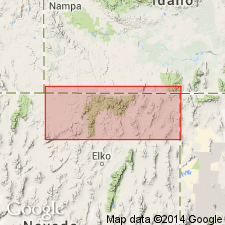
- Usage in publication:
-
- Big Island Formation*
- Modifications:
-
- Named
- Dominant lithology:
-
- Gravel
- Tuff
- Basalt
- AAPG geologic province:
-
- Snake River basin
- Great Basin province
Summary:
Named for exposures on west wall, Jarbidge River canyon, in C, N1/2 sec 28, T16S, R9E, Owyhee Co, ID in the Snake River basin in the Dishpan quad. Is exposed on Big Island, a plateau between the Jarbidge River and its East Fork. Extends into Twin Falls Co, ID, Snake River basin and Elko Co, NV, Great Basin province. Overlies late Miocene Cougar Point Welded Tuff. Underlies Quaternary unconsolidated deposits. Name Banbury Formation (Basalt, or Volcanics) previously applied to these rocks. Consists of: 1) lower unit about 104 m thick composed of gravel whose clasts range from pebble to boulder size derived from the Jarbidge Rhyolite and the Cougar Point Welded Tuff, 2) middle unit 6 m thick of rhyolitic fine-grained tuff that is generally dacitic, has quartz, plagioclase, and in which sanidine is scarce; most common mineral is augite, biotite and hornblende are less common; and 3) upper unit of dark-gray, tholeiitic olivine basalt 60 m thick. Miocene age based on stratigraphic position above Cougar Point and K-Ar determinations of 7.9 +/-0.5 to 10.6 +/-1.0 m.y. from basalt samples.
Source: GNU records (USGS DDS-6; Denver GNULEX).
For more information, please contact Nancy Stamm, Geologic Names Committee Secretary.
Asterisk (*) indicates published by U.S. Geological Survey authors.
"No current usage" (†) implies that a name has been abandoned or has fallen into disuse. Former usage and, if known, replacement name given in parentheses ( ).
Slash (/) indicates name conflicts with nomenclatural guidelines (CSN, 1933; ACSN, 1961, 1970; NACSN, 1983, 2005, 2021). May be explained within brackets ([ ]).

